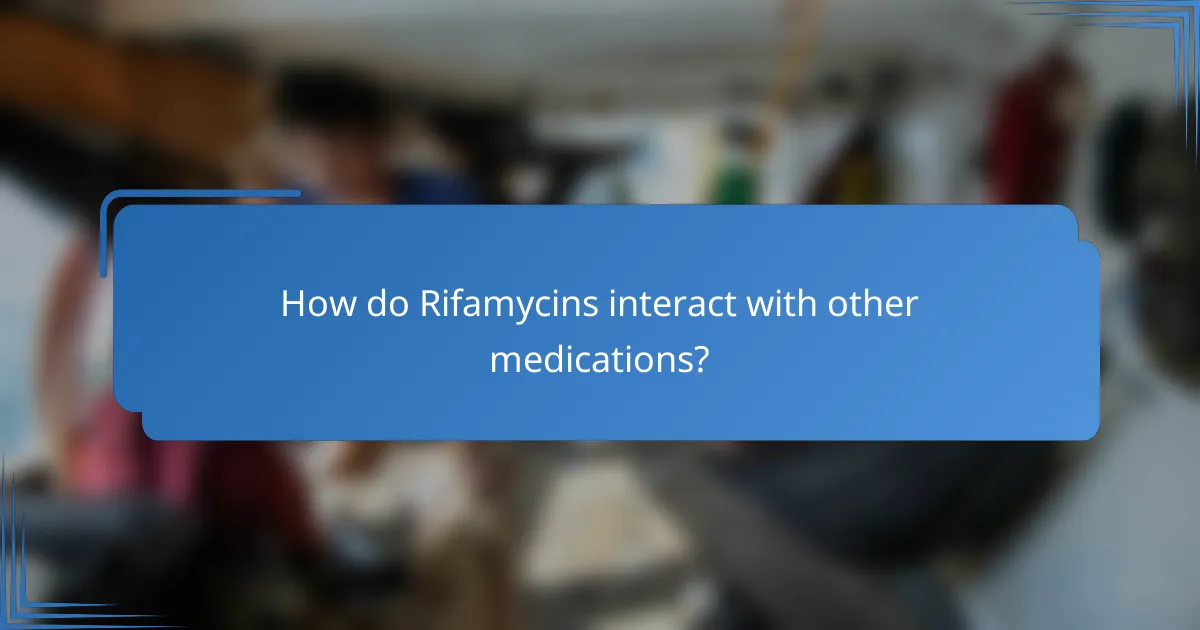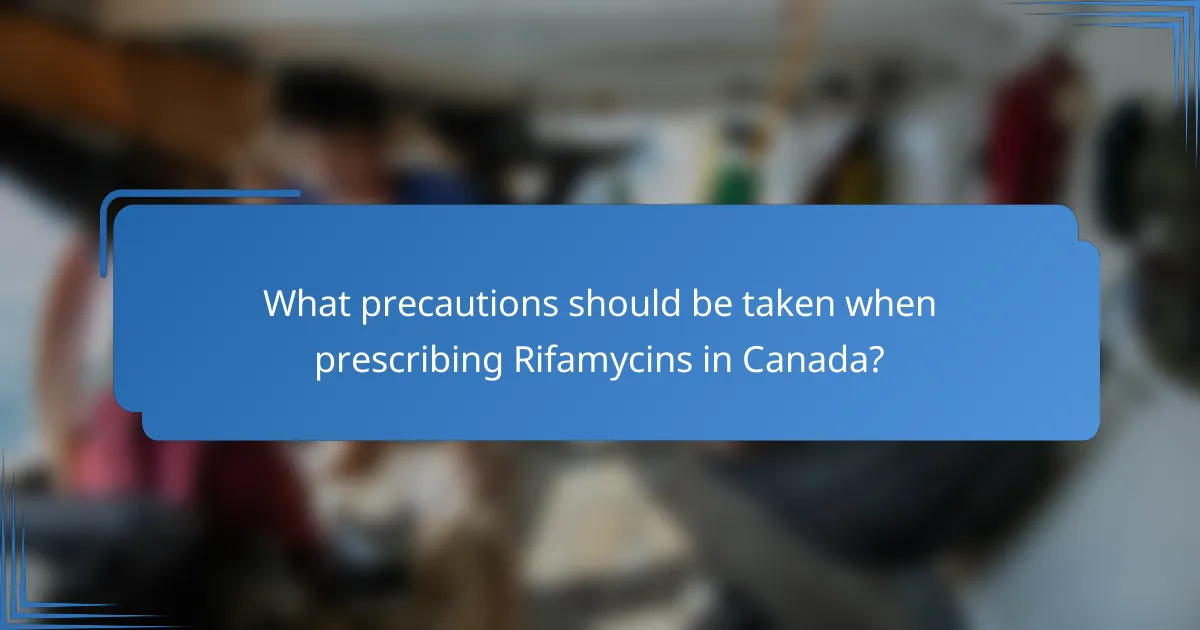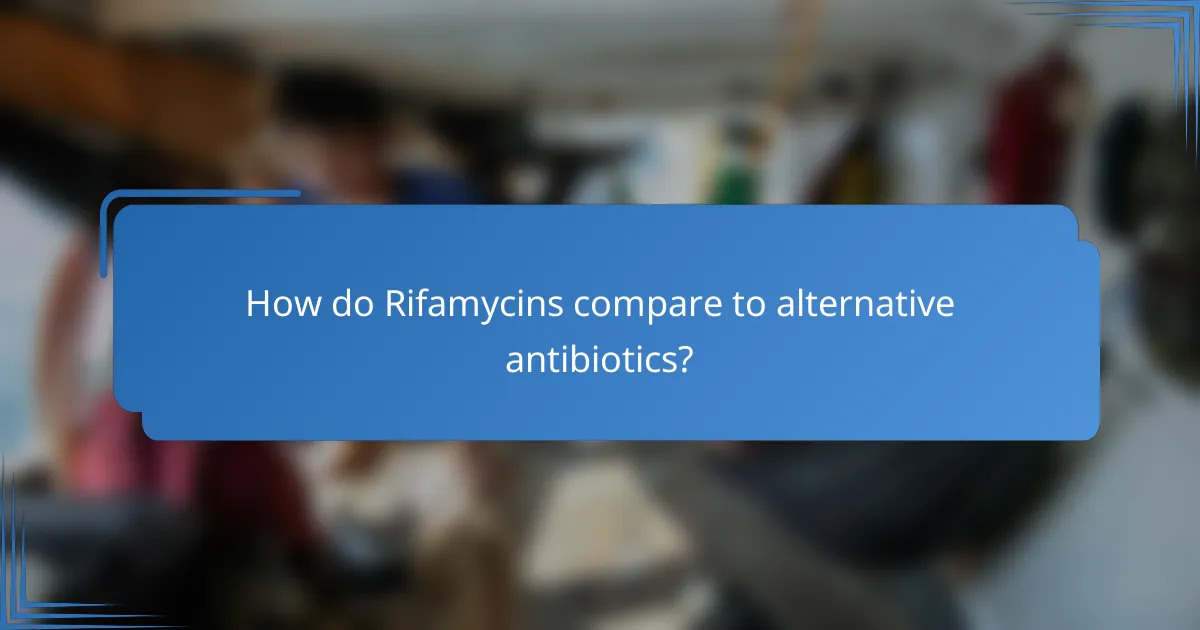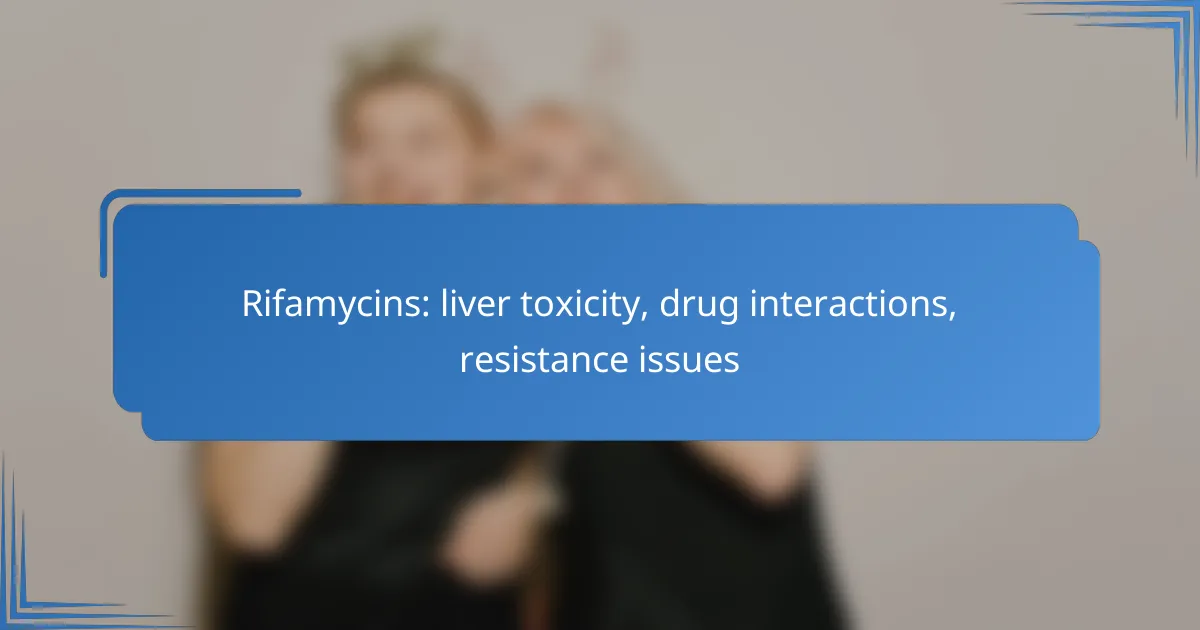Rifamycins are a class of antibiotics known for their potential to cause liver toxicity, especially in patients with pre-existing liver conditions, making careful monitoring essential during treatment. Additionally, these drugs can significantly interact with other medications by inducing liver enzymes, particularly cytochrome P450, which may diminish the effectiveness of co-administered therapies. Resistance to Rifamycins often results from mutations in bacterial DNA, leading to treatment failures and highlighting the importance of addressing these issues in clinical practice.

What are the liver toxicity risks of Rifamycins?
Rifamycins, a class of antibiotics, can pose significant liver toxicity risks, particularly in individuals with pre-existing liver conditions. Understanding these risks is crucial for safe prescribing and monitoring during treatment.
Acute liver injury
Acute liver injury can occur with Rifamycins, leading to symptoms such as jaundice, fatigue, and abdominal pain. This condition may arise within weeks of initiating therapy, especially in patients with underlying liver disease or those taking multiple medications.
Clinicians should be vigilant for signs of liver dysfunction, particularly in high-risk populations. Immediate discontinuation of the drug is recommended if acute liver injury is suspected.
Chronic liver disease exacerbation
For patients with chronic liver disease, Rifamycins can exacerbate existing conditions, potentially leading to further liver damage. This risk is particularly pronounced in individuals with cirrhosis or hepatitis, where liver function may already be compromised.
Close monitoring and dose adjustments may be necessary to minimize the risk of exacerbation. Healthcare providers should evaluate the benefits and risks before prescribing Rifamycins to these patients.
Monitoring liver function tests
Regular monitoring of liver function tests (LFTs) is essential during Rifamycin therapy. Baseline LFTs should be established prior to treatment, followed by periodic assessments to detect any early signs of liver toxicity.
Typically, LFTs should be checked at least monthly during the first few months of therapy. If abnormal results are noted, further evaluation and potential discontinuation of the medication may be warranted.

How do Rifamycins interact with other medications?
Rifamycins can significantly alter the effectiveness of various medications due to their strong induction of liver enzymes, particularly cytochrome P450. This interaction can lead to reduced therapeutic effects of co-administered drugs, necessitating careful monitoring and potential dosage adjustments.
Common drug interactions
Rifamycins, such as rifampicin, commonly interact with medications like oral contraceptives, certain antiepileptics, and some anticoagulants. These interactions often result in decreased plasma concentrations of the affected drugs, which can compromise their efficacy. For example, women using hormonal contraceptives may experience unintended pregnancies due to reduced effectiveness when taking rifamycins.
Other notable interactions include those with drugs like methadone and statins, where rifamycins can lower the levels of these medications, leading to withdrawal symptoms or increased cholesterol levels, respectively. It is crucial to review all medications with a healthcare provider before starting rifamycins.
Impact on antiretroviral therapy
Rifamycins can significantly impact the effectiveness of antiretroviral therapies, particularly those involving non-nucleoside reverse transcriptase inhibitors (NNRTIs) and protease inhibitors (PIs). The induction of liver enzymes by rifamycins can lead to decreased levels of these antiretrovirals, potentially resulting in treatment failure and the development of resistance.
Healthcare providers often recommend alternative treatments or dosage adjustments for patients on antiretroviral therapy who require rifamycins. Close monitoring of viral loads and drug levels is essential to ensure effective treatment outcomes.
Effects on anticoagulants
Rifamycins can reduce the effectiveness of anticoagulants, particularly warfarin, by increasing the metabolism of these drugs through liver enzyme induction. This can lead to a higher risk of thromboembolic events if anticoagulant levels drop too low.
Patients on anticoagulants should have their INR (International Normalized Ratio) closely monitored when starting rifamycins. Adjustments to anticoagulant dosages may be necessary to maintain therapeutic levels and ensure proper blood thinning.

What are the resistance issues associated with Rifamycins?
Resistance issues with Rifamycins primarily arise from mutations in bacterial DNA that reduce drug efficacy. These mutations can lead to treatment failures, making it crucial to understand and address them in clinical settings.
Mechanisms of resistance
Bacteria can develop resistance to Rifamycins through several mechanisms, including mutations in the rpoB gene, which encodes the RNA polymerase target of the drug. These mutations alter the binding site of the antibiotic, diminishing its effectiveness. Additionally, efflux pumps may expel the drug from bacterial cells, further contributing to resistance.
Another mechanism involves the modification of the drug itself, which can occur through enzymatic processes that render Rifamycins ineffective. Understanding these mechanisms is essential for developing effective treatment strategies.
Impact on treatment efficacy
The emergence of resistance can significantly impact the efficacy of Rifamycins in treating infections, particularly tuberculosis. In resistant strains, treatment regimens may require longer durations and the use of alternative, often less effective, antibiotics, which can lead to increased healthcare costs and patient morbidity.
In some cases, resistance can lead to treatment failures, necessitating more aggressive and complex therapeutic approaches. This highlights the importance of monitoring resistance patterns in clinical practice.
Strategies to mitigate resistance
To mitigate resistance to Rifamycins, healthcare providers should ensure appropriate use of the drug, including adherence to prescribed regimens and avoiding unnecessary prescriptions. Regular susceptibility testing can help identify resistant strains early, allowing for timely adjustments in treatment.
Additionally, combination therapy with other antibiotics can reduce the likelihood of resistance developing. Educating patients about the importance of completing their treatment can also play a critical role in preventing resistance.

What precautions should be taken when prescribing Rifamycins in Canada?
When prescribing Rifamycins in Canada, healthcare providers must consider potential liver toxicity, drug interactions, and the risk of developing resistance. It is crucial to conduct thorough patient assessments and monitor liver function regularly to mitigate these risks.
Patient screening criteria
Before initiating Rifamycins, patients should be screened for pre-existing liver conditions, such as hepatitis or cirrhosis, as these can increase the risk of hepatotoxicity. Additionally, a review of the patient’s current medications is essential to identify potential drug interactions that could exacerbate side effects.
Patients with a history of alcohol use disorder or those taking other hepatotoxic drugs should be monitored more closely. It’s advisable to obtain baseline liver function tests to establish a reference point for future assessments.
Guidelines for liver function monitoring
Liver function tests should be conducted before starting Rifamycins and periodically during treatment, typically every 1-2 months. Monitoring should focus on liver enzymes such as ALT, AST, and bilirubin levels, which can indicate liver stress or damage.
If liver enzyme levels rise significantly, it may be necessary to adjust the dosage or discontinue the medication. Patients should be educated on the signs of liver toxicity, including jaundice, dark urine, and abdominal pain, and advised to report these symptoms immediately.

How do Rifamycins compare to alternative antibiotics?
Rifamycins are a class of antibiotics primarily used to treat bacterial infections, particularly tuberculosis. Compared to alternative antibiotics, they are highly effective but come with specific considerations regarding liver toxicity, drug interactions, and resistance issues.
Effectiveness against tuberculosis
Rifamycins, especially rifampicin, are considered first-line treatments for tuberculosis (TB) due to their potent bactericidal activity. They significantly reduce the duration of treatment and improve outcomes when used in combination with other anti-TB medications.
In clinical settings, rifampicin is often administered alongside isoniazid, pyrazinamide, and ethambutol to enhance effectiveness and prevent resistance. This combination therapy is crucial for managing drug-sensitive and drug-resistant TB cases.
Side effects comparison
Rifamycins can cause side effects such as liver toxicity, gastrointestinal disturbances, and hypersensitivity reactions. These side effects are generally manageable but require monitoring, particularly liver function tests during treatment.
In contrast, alternative antibiotics may have different side effect profiles. For instance, fluoroquinolones can lead to tendon damage, while macrolides may cause gastrointestinal upset. Patients should be informed about potential side effects of both rifamycins and alternatives to make informed decisions.
Cost considerations for e-commerce
The cost of rifamycins can vary significantly based on the country and the healthcare system. In the United States, rifampicin can range from $100 to $300 for a typical course, while in Europe, prices may be lower due to different pricing regulations.
When purchasing antibiotics online, it is essential to consider both the price and the legitimacy of the source. Ensure that the e-commerce platform is reputable and that the medications are sourced from licensed pharmacies to avoid counterfeit products.

What are the emerging trends in Rifamycins research?
Emerging trends in Rifamycins research focus on understanding liver toxicity, drug interactions, and resistance issues. Researchers are exploring ways to mitigate these challenges while enhancing the efficacy of Rifamycins in treating infections.
Liver Toxicity
Liver toxicity is a significant concern with Rifamycins, particularly with rifampicin. This toxicity can manifest as elevated liver enzymes or, in severe cases, liver failure. Monitoring liver function tests is essential for patients on long-term Rifamycins therapy.
To minimize the risk of liver toxicity, healthcare providers often recommend regular blood tests, especially in patients with pre-existing liver conditions. Patients should be educated on recognizing symptoms of liver dysfunction, such as jaundice or unexplained fatigue.
Drug Interactions
Rifamycins are known to interact with various medications, primarily due to their effect on liver enzymes that metabolize drugs. This can lead to reduced effectiveness of co-administered drugs or increased toxicity. For example, Rifampicin can significantly lower the effectiveness of oral contraceptives.
Clinicians should review a patient’s medication regimen thoroughly before initiating Rifamycins. Adjusting dosages or selecting alternative therapies may be necessary to avoid harmful interactions. Patients should be advised to inform their healthcare providers about all medications they are taking.
Resistance Issues
Resistance to Rifamycins, particularly rifampicin, is a growing concern in the treatment of tuberculosis and other infections. The emergence of resistant strains can complicate treatment regimens and lead to poorer patient outcomes. Resistance often arises from incomplete treatment courses or suboptimal dosing.
To combat resistance, it is crucial to adhere to prescribed treatment regimens and complete the full course of therapy. Ongoing research is focused on developing new Rifamycins derivatives that may overcome existing resistance mechanisms, providing hope for more effective treatments in the future.
